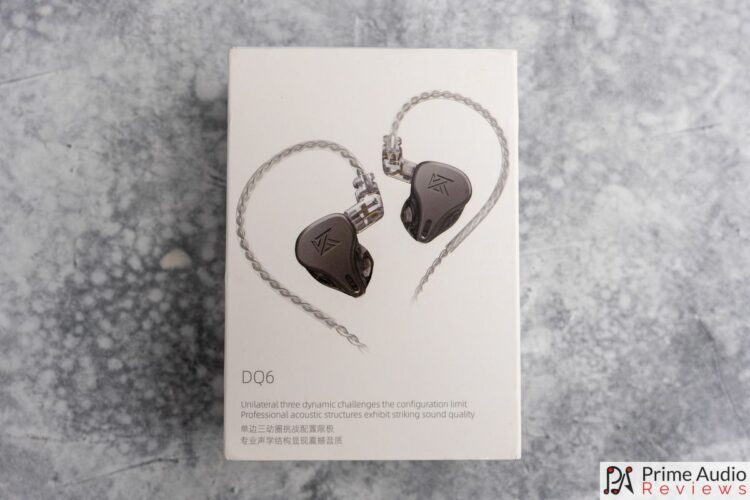In this review, I’m checking out the KZ Dq6, a triple-driver earphone with 3 dynamic drivers per side. This is a big shift from their recent multi-BA models which seemed to increase the number of driver within with each consecutive release.
I have somewhat of a love-hate relationship with the KZ (Knowledge Zenith) reptilian overlords. They’ve made many amazing and affordable products and have given birth to multitudes of new enthusiasts and audiophiles. But they’ve made some terrible (in my opinion) products too; at times it seems like they’re using random number generators to come up with new models. So where does DQ6 fit in? Let’s go.
Disclaimer: This sample was provided for the purpose of an honest review. All observations and opinions here are my own based on my experience with the product.
KZ DQ6
Specifications
- Driver unit: 10mm dual magnetic dynamic unit + 6mm single magnetic dynamic unit x2
- Impedance: 24Ω
- Frequency range: 20-40000Hz
- Earphone sensitivity: 112dB/mW
- Earphone interface: 2Pin 0.75mm gold-plated
Packaging & Accessories
As per usual, there’s not a lot to say about KZ’s packaging. It’s as minimalist as possible which by now, we know is part of how they can keep their prices low. So, it’s a small white box with an image of the earphones on the front and a list of specifications on the back. Inside the box is the DQ6 earphones, a detachable Type-C 2-pin cable and 3 pairs of teeny tiny silicone eartips.
Design
DQ6’s three dynamic drivers are enclosed in dark, transparent acrylic shells. Aluminium faceplates adorn the outer shells. The faceplates have a smooth matte finish with the KZ logo engraved in the centre. There’s an elongated grill towards the bottom of the faceplate but I’m fairly certain it’s just for aesthetics and not an actual vent.
The nozzles are aluminium and have a proper lip for securing eartips but frustratingly, the nozzles have a smaller than average diameter which makes using 3rd party eartips more challenging; some of my go-to eartips kept slipping off so I had to do some searching to find ones with a narrower core.
Internally, DQ6 has a somewhat rare triple-driver configuration made up of 1x10mm dual magnetic dynamic driver and 2x6mm single magnetic dynamic drivers. Despite having 3 diaphragms inside, DQ6’s housings are a LOT smaller than the ASF and ASX models.
When it comes to comfort, DQ6 feels great in my ears and I can wear them comfortably for extended periods. The fit feels natural and the shells don’t protrude too much out the sides of my ears and I can pretty much forget they’re there at all. Furthermore, the housings have a rounded, smooth surface so there are no hot-spots even after hours of use.

Cable
Included with DQ6 is KZ’s new default cable. It’s a 4-core SPC model with transparent plastic Type-C 2-pin connectors and heat-shrink ear hooks. It also has an opaque plastic Y-split and right-angled 3.5mm termination.
In my opinion, this is an upgrade from the old KZ brown cable but it is still a tangly bastard because of those ear hooks and thinness above the Y-split. Apart from being prone to tangling the cable handles quite well. It has minimal microphonics and drapes nicely.

Sound
Gear used for testing includes:
- Windows laptop -> Lotoo PAW S1
- Windows PC -> Topping DX7 Pro
- iPhone -> Hidizs H2
- iBasso DX120
Housing triple dynamic drivers, you might expect KZ DQ6 to be a bass monster but it’s not. It does, however, have a monster bass, which I’ll get to in a minute. On my first listen, DQ6 sounded a bit dark but that was probably due to being conditioned to multiple Chi-Fi clarity whores prior. After a night of burn-in and with a fresh pair of morning ears DQ6 showed me its true nature.
In reality, KZ DQ6 is a well-balanced, organic and natural-sounding IEM that (at least for me) points to a return to the brand’s stellar early days when dynamic drivers were the norm. Gone is the metallic, artificial and dry treble of recent KZ models. Gone is the ultra-clarity that admittedly can be impressive but ultimately relies on an uncomfortably elevated lower treble.
Instead, DQ6 brings great tonal balance, a very impressive low end, inviting midrange and a treble that is easy on the ears yet is still airy and able to retrieve detail. Let’s take a closer look by breaking it down into some bite-sized chunks.

Bass
KZ DQ6’s bass is deep and powerful but delivered with a calm spirit. The sub-bass gets a mild lift over the mid-bass and gives the rest of the sound spectrum a solid foundation to rest on without any bloat. It sets a precursor for the overall tonal balance that DQ6 achieves.
While it’s not elevated all that much in terms of quantity the bass feels authoritative and confident. It hits with impact and drive yet is always composed and controlled. On the majority of tracks, the bass seems confident but mild-mannered. Then, when you’re least expecting it, the bass will bare its teeth and make you sit up and take notice in a hurry.
A good track to showcase DQ6’s low-frequency ability is “Screening” by Mr Bill where the bass is delivered with force and conviction. DQ6 does this really well with huge impact, excellent control and no lingering resonance. It’s self-assured and doesn’t need to showboat but you feel its presence.
Mids
DQ6 has a warm, natural and clear midrange. Male vocals sound full-bodied yet articulate while female vocals are clear and vibrant but never petulant or shrill. Instruments have a natural tone, even if they do have a slight undertone of added warmth.
Midrange resolution is solid overall and the instrument separation is quite good too, especially considering the underlying body of the bass. Acoustic guitars sound great and vocals are smooth with no signs of overt thickness.
Treble
DQ6 treble is rhythmic, melodic and crisp. It’s just slightly warm but well-defined, detailed and airy. This is the perfect example of a treble that can be smooth and at the same time is able to deliver abundant details.
Simply put, this is the best treble I’ve heard on a KZ earphone for some time. It’s still not perfect though (remember this IS a $2x IEM after all) and the 5kHz and 7kHz peaks get a little sharp at high volumes. Having said that, this is a great quality treble for a budget IEM and I hope KZ does more like this with future releases.
In Ludovico Einaudi’s “Indaco”, every single press of the piano’s pedal can clearly be heard, which is something even more expensive, bright and ultra-clear IEMs often fail to achieve. This is more impressive than it might sound when considered in the context of DQ6’s overall tonality.
Soundstage
The soundstage has average dimensions with a good sense of width but it’s a little shallow in depth. There’s not much layering but stereo imaging is quite solid. Instrument separation is pretty good too and DQ6 holds things together fairly well without getting too congested.

Comparisons
KBEAR KS2 ($24)
The KBEAR KS2 is a dual-driver hybrid with 1 dynamic driver and one balanced armature driver. KS2 is more v-shaped with boosted bass and treble levels with a slightly recessed midrange. KS2 has more bass emphasis plus a slightly sharper leading edge on bass notes. DQ6, on the other hand, has more impact and is more in balance with the mids and highs. Both earphones can rumble and have a satisfying sub-bass response.
KS2’s midrange is slightly more recessed but at the same time, it has superior clarity and instrument separation. DQ6 sounds a bit more natural and cohesive in comparison. In terms of treble, KS2 is more precise, however, it puts more emphasis on the true treble while DQ6 lifts the presence region making vocals more forward and exciting.
KS2’s stage has slightly larger dimensions and superior instrument separation but DQ6 is very earthy and cohesive. KS2 might get a slight edge in soundstage but DQ6 comes out ahead in tonality and naturalness.
These are two amazing IEMs when the price is taken into consideration. I think the KZ has slightly better build quality and materials mainly due to its aluminium faceplate. Both IEMs are comparable when it comes to comfort and both are very good in this regard.

Conclusion
The KZ DQ6 is a genuinely good triple dynamic driver earphone. It makes me think back to some of the wonderful models from the KZ glory days such as the ED2 and ED9. Sure, DQ6 doesn’t have an absurd level of clarity or mind-blowing driver count but what it does have is a good, wholesome and musical sound that helps you enjoy music. Good job KZ.












